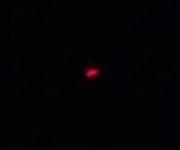I was playing around with a cheap diffraction grating and my set of laser pointers, and I noticed that while the red and the blue pointers produce a single point in the spectrum, my green laser produces three:



I've googled for green laser pointer spectra and the images I find seem to suggest that I should really see a single peak, not three. This answer also talks about a single frequency. Keep in mind that these are super-cheap lasers, I paid about $20 total for the three.
So is my green laser emitting multiple frequencies, or this some artifact of the diffraction grating I use? If it's really emitting three peaks, what causes this? From my (very basic) understanding of lasers, I thought this isn't supposed to be possible.
P.S. Here's the spectrum of a white LED flashlight taken using the same grating, in case it's relevant to judging my method:
